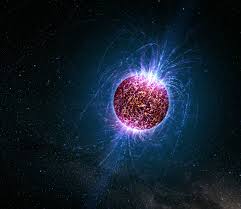
For a classification of stars see The H-R Diagram.
A neutron star is a stellar remnant. It is known that they have planets. Their deadly radiation used to be believed to preclude a Habitable Zone, but more recent information reveals habitable planets can even orbit pulsars, which are neutron stars.
The star[]
A neutron star is a very small body (a diameter of 10 to 15 km), but with a mass of 1.4 to 2.16 times our sun, Sol. Matter is so tightly packed inside, that electrons merge into protons, creating neutrons. The stellar core is made of neutrons, packed together. The entire star has a density similar to an atom nucleus. Therefore, some might consider a neutron star as a giant atom.
Neutron stars are very hot. Their temperature varies from 100 000 K to millions of degrees. As so, they appear to be perfectly white to the naked eye, even if the largest part of their light is in ultraviolet and X - rays. Their overall energy output is not high. If one neutron star is to be placed instead of Sol, Earth will face temperatures similar to Uranus, but the deadly radiations will kill any living creature as far as Ceres. The star does not emit the same amount of light in each direction. So, since it spins fast, it appears to change its light intensity very fast.
Neutron stars have a gigantic gravity force. Their escape velocity is 100 000 km/s. So, only light can leave them. If an object (for example a grain of dust) falls on such a star, gravity acceleration will increase its speed and it will fall with so much energy, that it will generate an explosion of X and gamma rays. Neutron stars seem to accumulate more heat from accretion of matter than they can radiate on their small surface. However, compared to the lifetime of a settler, there is nothing to worry.
Hosted planet[]
It is proven [1] that planets exist around neutron stars.
Given the small overall energy output of a neutron star, the Habitable Zone should be very close to the star, probably around 0.2 AU. However, since these stars generate deadly doses of radiation (gamma, X-rays and UV), it is unlikely that such a planet could be terraformed. Radiation might break molecules down very fast, so that we more than likely will not find water there. Also, as a direct effect, any atmosphere will be highly ionized. Since atoms are lighter than molecules and ionized gases can move fast, there may be no atmosphere. Only a gigantic shield, produced by an unknown technology, can save such a planet. Even then, you will still need to add water and many missing molecules and atoms to the planet.
Neutron stars are what is left after a dying star went supernova. So, their planetary system is supposed to be wiped away. The planets discovered must have formed from the remnants of that supernova. So, it is unlikely that they contain any light elements (hydrogen or helium). They might have a huge concentration of heavy elements. Even if their hosting stars are so deadly, the high abundance of rare and expensive metals will bring settlers for sure. On the other hand, after a supernova, any previous Kuiper Belt objects should also die in the blast. Hydrogen (and also water) should be extremely rare around a neutron star. Importing water from nearby star systems would be too expensive.